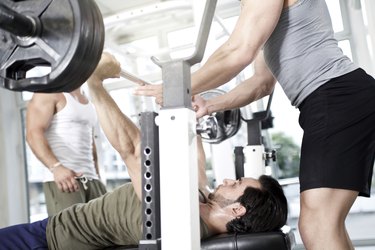
Creating symmetry in the body is one of the most crucial aspects of competitive bodybuilding. Unfortunately, this can be quite a challenge because your dominant arm tends to be stronger and more developed than your non-dominant arm. You can address this issue by making some alterations to your training and by changing some aspects of your daily life. In time, the size and strength of your arms will balance out and will make keeping your arms the same size much easier.
Dominant Arm Size
Video of the Day
There are two primary reasons why your dominant arm is usually larger than your non-dominant arm. Your neural connection to your dominant side is stronger than your non-dominant side. This allows you to recruit muscle fibers more readily and supports a slighter increase in strength. This natural increase in strength leads to a progressive cycle that facilitates the continued development of the dominant arm over the non-dominant arm. Everyday activities are usually performed utilizing the dominant arm first. As a result, the dominant arm receives more training and focus, which further augments the neural control.
Video of the Day
Training Solutions
There is an in-training and out-of-training solution to restoring the size balance between your dominant and non-dominant arms. When performing single arm exercises during your bodybuilding routine, you should always start with the non-dominant side. Perform your desired reps for your exercise with the non-dominant arm, and then match it with the dominant arm. This will ensure that the same amount of work is being performed on each side. A common mistake is to start with the dominant arm and then perform a number of reps for an exercise that cannot be matched with the non-dominant side. For exercises that require both arms, you should always stop completing repetitions when you feel the non-dominant arm is moderately fatigued. Continuing past this point will force your dominant arm to compensate and further reinforce the size difference.
Out-of-Training Solutions
The difference in arm size must also be addressed in how you perform everyday activities. You need to consciously utilize your non-dominant arm more often. For instance, when picking up a television remote, a book or some groceries your natural instinct is to use your dominant arm. To counter this, you need to start using your non-dominant arm to lift these objects. While this will not produce large strength or size differences by itself, it will reinforce the neural connection to the muscles in your non-dominant arm. Increasing the neural drive to the non-dominant side will allow your arm muscles to use heavier loads and resist fatigue when lifting weights.
Measurement
You also need to measure your progress to ensure that the size gap is shrinking between the dominant and non-dominant sides. You will need measuring tape, a marker and a partner to help you measure your body. Your partner should measure your upper arm from your shoulder joint to your elbow. They should mark the mid-point of your upper arm with the marker. Your partner then needs to wrap the measuring tape around your arm just below this mark. Record the measurement and repeat on your other arm. The other measurement you need is from your forearm. For this measurement, simply measure around the widest and thickest portion of your forearm.